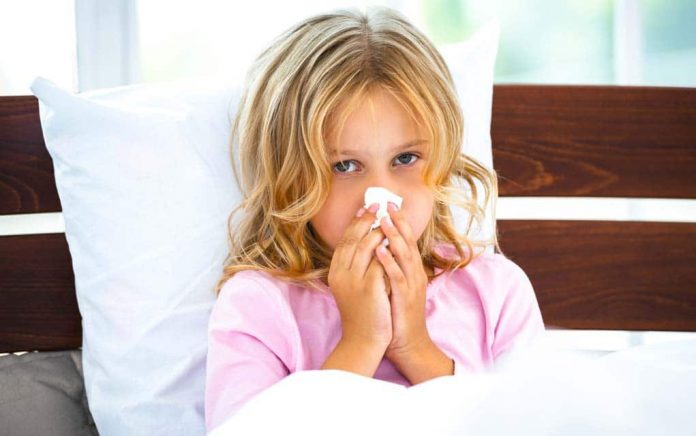
Last summer, my two-year-old daughter broke out in a rash that covered her whole body. It lasted a couple of days so I decided to take her to the doctor to check it out. He told me he was pretty sure it was an allergic reaction to something she ate. He confirmed what I was thinking.
He told me to go to the pharmacy to pick up a bottle of Children's Benadryl Allergy Liquid. So I went next door, and out of curiosity, checked out the ingredients on the bottle of Benadryl that he recommended. Then another bottle of a similar medication. And then a third. Every single one of them had one–if not several–Scary Seven ingredients. Even the dye-free formula, which I thought would be the best option, still contained chemical additives.
Here are the Inactive Ingredients of Children's Benadryl Dye-Free Allergy Liquid:
| INGREDIENTS: anhydrous citric acid, carboxymethylcellulose sodium, flavors, glycerin, purified water, saccharin sodium, sodium benzoate, sodium citrate, sorbitol solution. |
Here are the Inactive ingredients of Children's Benadryl Allergy Liquid (the regular one):
| INGREDIENTS:Anhydrous citric acid, D&C red no. 3, FD&C red no. 40, flavors, glycerin, monoammonium glycyrrhizinate, poloxamer 407, purified water, sodium benzoate, sodium chloride, sodium citrate, sucrose. |
Read more about the Scary Seven ingredients
Since I wasn't willing to settle for the harmful ingredients, I moved on
to the homeopathic remedies on the shelf. I couldn't find one that
specifically targeted what I needed, so I called over the pharmacist and
asked her to help me choose a homeopathic remedy specifically for
allergies. Here is how our conversation went:
Me: "Hi, I'm wondering if you could please help me choose a homeopathic remedy. I'm specifically looking for one that targets allergies. My two-year-old daughter has hives from something she ate so I'd like to give her something to make them disappear."
The Pharmacist: "Why do you want a homeopathic? They don't work, so I wouldn't want to recommend them."
Me: (Shocked and surprised): "I use them all the time and I think they work great. I'm not sure why you would say something like that especially since I am asking you to help me choose one."
The Pharmacist: "Well, I don't know too much about them."
Me: "Have you ever asked a representative from a homeopathic company to come in and educate you on how and why they work? I have worked with many homeopathic companies and I know for sure that they would be more than happy to come in a meet with you. I'm surprised that someone in your position would immediately put homeopathics down. They have been around for hundreds of years and they work really well on children."
The Pharmacist: "I would be open to that."
Me: "Great. I have one more question. Why do some of the SKUs have artificial sweeteners? If it's not dyes, or preservatives, it's sucralose, which is a chemical sweetener."
The Pharmacist: "That's because parents complained that there was too much sugar in medications, so companies listened and replaced it with calorie-free alternatives."
So I checked the ingredients to see which chemical sweetener they replaced the sugar with.
Below are the inactive Ingredients of Children's Benadryl-D Allergy & Sinus Liquid:
| INGREDIENTS: Anhydrous citric acid, carboxymethylcellulose sodium, edetate disodium, FD&C blue no. 1, FD&C red no. 40, flavors, glycerin, purified water, sodium benzoate, sodium citrate, sorbitol solution, sucralose. |
They replaced it with sucralose – a chemical sweetener linked to a decrease in good bacteria in the gut (although its makers, Johnson & Johnson sent me an email stating the Duke University study on sucralose was refuted).
So, after that whole conversation, I picked the homeopathic remedy that closely described my daughter's symptoms (Boiron's Sabadil) and gave her one dose.
Her rash was gone two hours later.
The thing that bothered me most about my conversation with that pharmacist was her immediate brush off of something
she clearly knew NOTHING about, and up to this point, wasn't even interested
in learning about. I absolutely believe there is a time and place for medication. We have used it on many occasions when it was necessary. However, I prefer to try natural remedies first, especially when it comes to something like a mild reaction to food.
Here's a quick video on Benadryl worth watching:
Have you ever encountered a situation like this? How did you react?
Photo Credit: theloushe










